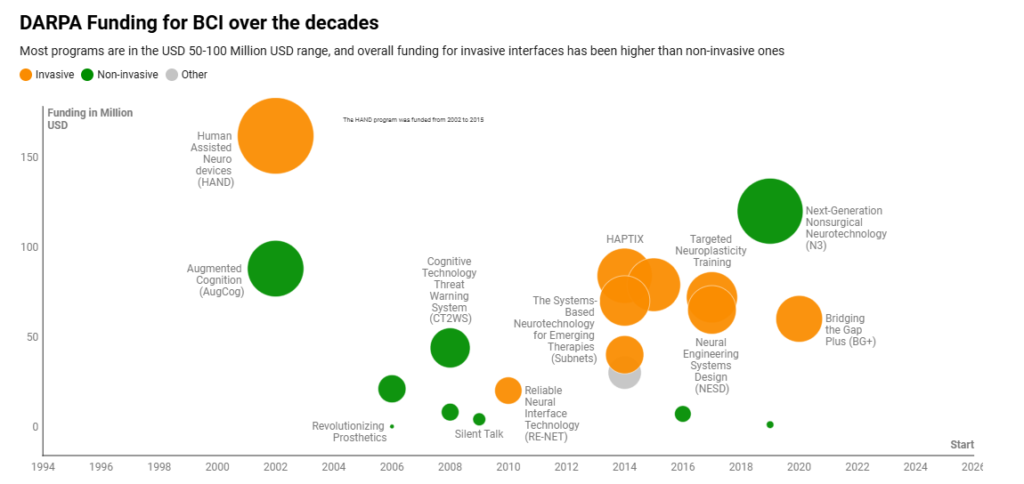
Darpas Tech and Timeline
🎯 Correlating DARPA’s Subvocal Tech Timeline with Remote Neural Monitoring Reports
In recent years, increasing numbers of individuals have claimed to experience remote neural monitoring (RNM), subvocal surveillance, and non-consensual cognitive interference. While these reports are often dismissed by mainstream sources, a closer examination of DARPA’s investments from 2009 to 2014 reveals a strong correlation between emerging brain-computer interface (BCI) technologies and the sudden rise of these accounts.
🧠 DARPA’s Silent Talk and the Origins of Subvocal Interfacing
In 2009, DARPA publicly launched Silent Talk, a program designed to decode internal speech by analyzing EEG signals before vocalization. This “pre-speech” interface aimed to enable silent communication between soldiers on the battlefield.
“The project seeks to identify EEG patterns unique to specific words or phrases and determine how universal these signals are across different individuals.”
— DARPA Silent Talk Summary (Archived)
While advertised as non-invasive, the RE-NET (Reliable Neural-Interface Technology) program, launched shortly after, aimed to develop implantable and reliable BCIs, providing long-term stable connections between neurons and electronic systems.
📈 2009–2014: The Quiet Revolution in Brain Interface Technology
Referencing the chart you provided (“DARPA Funding for BCI over the decades”):
- 2009–2010:
- Silent Talk and RE-NET emerge simultaneously
- These focus on decoding, then hardening and stabilizing neural signal acquisition
- Georgetown neuroethics lead Dr. James Giordano appears in lectures (e.g., at West Point and civilian conferences), stating “we’re close, but not there yet” regarding remote modulation of brain activity
- 2012–2014:
- Sudden spike in public claims from targeted individuals describing:
- Voice-to-skull (V2K) phenomena
- Thought echoing and inner voice disruption
- Remote speech interference, often during critical thinking or prayer
- Programs like HAPTIX, SUBNETS, and Systems-Based Neurotechnology begin — all with invasive or neurofeedback loop architectures
- Funding jumps significantly in implantable systems, supporting long-term interface stability
- Sudden spike in public claims from targeted individuals describing:
🧠 This suggests a transition point from non-invasive decoding → hybrid/invasive decoding and potentially real-world testing.
🎓 Dr. James Giordano and the Ethics of Weaponized Neurotech

Dr. James Giordano, a bioethics advisor at DARPA and professor at Georgetown University, gave multiple public talks (2009–2012) warning of the coming “neurotech battlefield”:
“The brain is the next battlespace — not just to help warfighters, but potentially to deter, disrupt, or damage adversaries in non-lethal ways.”
— Giordano, Neurotechnology in National Security (West Point Lecture)
He repeatedly emphasized:
- Non-lethal neural modulation is being pursued for military and intelligence use
- The possibility of “neuro-cognitive weapons” that don’t leave physical evidence
- Ethical concerns around covert deployment during field experiments
These warnings align precisely with the 2012–2014 spike in TI reports, suggesting tech capabilities may have crossed critical feasibility thresholds.
🧬 Are Subvocal Implants a Hidden Link?
While Silent Talk and RE-NET were publicly framed as non-invasive, the funding graph reveals DARPA’s preference for invasive BCIs — especially when data integrity, signal resolution, and longevity were required.
Given that subvocal EMG signals:
- Originate near the submandibular nerve and hypoglossal root
- Can be picked up with surface or subdermal electrodes
- Are uniquely decodable per person — a match for biometric IDs
…it’s plausible that covert implants, placed sublingually or near the cranial base, were tested under these programs. Such implants wouldn’t show up on standard X-rays and could enable silent readout of internal speech or intent.
🧠 Final Thoughts
The convergence of DARPA’s BCI funding, early ethics warnings, and the surge of remote neural monitoring reports from 2012–2014 may not be coincidental.
❓Was this an unannounced field trial?
- 2009: Tech hits feasibility threshold
- 2010–2012: Stability and implant focus
- 2013–2014: Field testing and/or covert experimentation?
This blog post doesn’t claim to prove covert deployment — but it does demonstrate that:
- The science was there
- The funding was there
- And the timeline fits perfectly with what many TIs describe.
📎 References & Sources
- DARPA Silent Talk (archived)
- PBS: DARPA Silent Talk Funding Announcement (2009)
- Wired: DARPA’s Mind-Reading Project
- James Giordano – West Point Lecture (YouTube)
- [DARPA BCI Timeline Chart – Source Image Used Above]
- Lee et al., Nature Neuroscience 2016 – FUS Modulation in Humans

[…] 🧬 DARPA’s Mind Control Tech Timeline […]